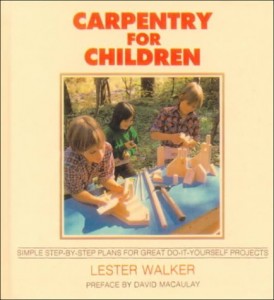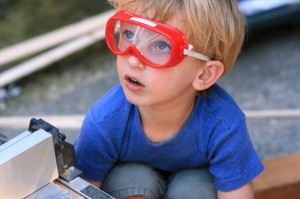Carpentry and simple construction provide great lessons in basic math – and give help in understanding more complex geometry. From counting nails and the turns of a screw to talking about geometric angles and degrees, a building project can be building more than a piece of furniture or a piece of a house; it can build an understanding of how basic geometric shapes and planes work and fit together to create our world. Carpentry can provide fun math activities.
So where can we begin with our children to help them learn math through basic construction, especially if we don’t know anything about it ourselves?
Here are two outstanding books that will give children, as well as youth and adults,
all the information they need to enter the world of carpentry; Carpentry for Children and Housebuilding for Children by Lester Walker. These books are exciting and inspiring. They have great content on basic carpentry projects.
Both books are simply written – most 7 to 10 year olds should have no trouble following the directions with minimal or no adult assistance. There are line drawings and diagrams on every page, as well as photographs of children hammering, sawing, drilling, and assembling and using their carpentry projects. But these books aren’t just for young children. Older children and adults will also appreciate the clear, detailed instructions on buying and using tools and setting up a workshop, and the step-by-plans.
Walker worked with his son, Jess (7 years old at the time Housebuilding for Children was written, and 12 in Carpentry for Children) and a group of other children, who built all of the projects illustrated in the books. Carpentry for Children contains projects ranging in complexity from a tug-boat and block set through stilts, lemonade stand, easel, and coaster car. The instructions make the success seem very attainable even for the youngest carpenters.
In the introduction to Housebuilding for Children , Walker writes, “This book is written for young people who want to build houses just as older people do.” There are designs for six child-sized houses that will satisfy any aspiring builder. After children work through the first book they will be ready to tackle a really big project. (Walker instructs his readers to saw 100 cuts and drive 100 nails for practice before starting on a serious project.)
Using math in everyday life is the best way to learn it. Remember this simple rule; find something they are interested in that uses math, then teach them how to do that!
For younger children start by making a keelboat out of Popsicle sticks.
Possibly Related Posts:
- 5 Creative Writing Exercises for Kids of All Ages
- 5 Ways to Help Your Child Think Like a Scientist
- The Pink Refrigerator-A book about a Closet, of sorts!
- How to deal with family opposition to homeschooling
- Children learn when interest is high







{ 3 comments… read them below or add one }
Fabulous math post. You know I am particularly fond of posts discussing simple math inclusion! 🙂
I had this book growing up. I loved it and always wanted to build the projects in it. Les Walker is local to me and knows my father so it was even more special to me.
Well this is wonderful. It is an amazing book and how cool to know the author. Thank you for dropping by and for letting us know how great the book is.